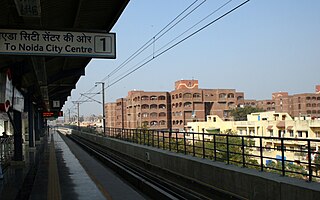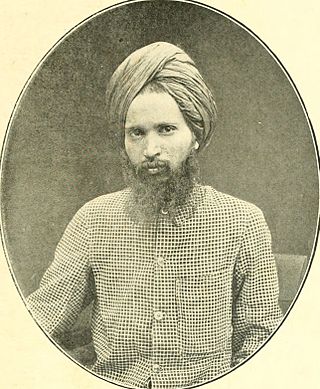
Mayur Vihar is an upmarket residential area in East Delhi close to the city's Noida-Delhi border, situated just across the Yamuna River, and is divided into three distinct phases. As the name suggests, it has been the dwelling (vihar) of peacocks (mayur). Even today, the area has a closed sanctuary dedicated to the conservation of peacocks.
Ramakrishna Puram popularly known as R.K. Puram, is a residential colony in Delhi. Named after the saint Sri Ramakrishna, it houses many high-profile corporate houses.

The Inner Ring Road refers to one of the two main ring roads, the main inner one and an outer one in Delhi, India. The two ring roads have a combined length of 87 km (54 mi). There are two less significant Ring Roads in Delhi apart from the above two, namely the Rural Ring Road, that runs across the rural areas on the fringe of North West Delhi and West Delhi Ring Road, limited only to the West Delhi region.
Rajouri Garden is a market and residential neighbourhood in West Delhi, India. The Main Market and Nehru Market are the key markets of the area. The population is largely Punjabi who migrated to Delhi, following the Partition of India, from Pakistan in 1947. The postal code of Rajouri Garden is 110027.
Dayanand Colony is part of the Lajpat Nagar area of Delhi. It falls under Lajpat Nagar-4 in South Delhi. By 1957, it was named after Dayanand Saraswati.

East Delhi is an administrative district of Delhi in India. It is bounded by the Yamuna River on the west, North East Delhi to the north, Ghaziabad District of Uttar Pradesh state to the east, and Gautam Buddha Nagar District of Uttar Pradesh to the south. Administratively, the district is divided into three subdivisions: Gandhi Nagar, Preet Vihar, and Mayur Vihar.
Malviya Nagar is a residential locality in South Delhi. Situated between Saket and Hauz Khas, its namesake is the freedom fighter Madan Mohan Malviya.

Lala Hansraj also known as Mahatama Hansraj, was an Indian educationist and a follower of Arya Samaj movement founder, Swami Dayanand. He founded, with Gurudatta Vidhyarthi, the Dayanand Anglo-Vedic Schools System (D.A.V.) in Lahore on 1 June 1886, where the first D.A.V. school was set up in memory of Dayanand who had died three years earlier.

The Green Line is a metro rail line of the Delhi Metro, a rapid transit system in Delhi, India. The line consists of 24 stations covering a total length of 28.79 km. It runs between Inderlok and Brigadier Hoshiyar Singh with a branch line connecting the line's Ashok Park Main station with Kirti Nagar station.

Anand Vihar is an interchange metro station located on the Blue Line and the Pink Line of Delhi Metro. The station is located in the Anand Vihar locality near the interstate border between Delhi and Uttar Pradesh and is a major connectivity hub of East Delhi. It is connected to the Anand Vihar ISBT and Anand Vihar Railway Terminal.

The Hauz Khas metro station is an interchange station between the Yellow Line and the Magenta Line of the Delhi Metro. It serves Hauz Khas Enclave, Sarvapriya Vihar, Vijay Mandal Enclave, RBI colony, Mayfair Gardens and the IIT Delhi. The entrance to the station is located on Outer Ring Road, to the east of Aurobindo Marg and to the west of Khelgaon Marg.

Jangpura is a Delhi Metro station in Delhi. It is located between JLN Stadium and Lajpat Nagar stations on the Violet Line in Jangpura locality. The station was opened with the first section of the Line on 3 October 2010, in time for the Commonwealth Games opening ceremony on the same day.

Lajpat Nagar is an interchange station between Violet Line and Pink Line of the Delhi Metro in Delhi. It is located between Jangpura and Moolchand on the Violet Line in Lajpat Nagar. The station was opened with the first section of the Violet Line on 3 October 2010, in time for the Commonwealth Games opening ceremony on the same day. It became an interchange station with the opening of the Pink Line on 6 August 2018. The station on the Pink Line is underground, whereas the Violet line station is elevated. However, both the lines are seamlessly connected, without commuters having to exit the ticketed area to interchange from one line to another.
Defence Colony is a neighbourhood in Delhi. It was built in the 1960s for veterans of the Indian Armed Forces. It serves as the administrative headquarters of the South East Delhi district of Delhi.
Pandav Nagar is a residential colony in East Delhi, India. The back side of the colony is across the road from the famous Akshardham Temple. The majority of the people are Hindus or Sikhs. Languages spoken are Hindi and Punjabi.
Jangpura is a neighbourhood in South East Delhi district of Delhi. Beginning from the east and moving clockwise, it is bordered by the Mathura Road, Ring Railway line, Silver Oak Park beyond the Defence Colony Flyover, and the Barapulla Nullah. It encompasses the residential areas of Jangpura A and B on either side of the Mathura Road, Jangpura (Bhogal) extending west from the Mathura Road until Jangpura Extension, which in turn extends along the northern side of the Ring Railway line to the east side of the Defence Colony Flyover on Josip Broz Tito Marg. The small colony of Pant Nagar along the Barapulla Nullah is contiguous with Jangpura Extension.
Krishna Nagar, Delhi is an urban ward situated in the East Delhi district of Delhi in the Trans-Yamuna area. It is surrounded by Vishwas Nagar, Gandhi Nagar, Preet Vihar & Geeta Colony areas.
Vikram Vihar is a residential colony located in the Lajpat Nagar area of New Delhi, Delhi, India. The colony is adjoined with other residential and commercial spaces including National Park, Guru Nanak Market, Old Double Storey, Dayanand Colony and Amar Colony. Vikram Vihar is well-connected to the Delhi Metro and the nearest metro station is the Moolchand Metro station on the Violet line. Hotel Park Inn is also located in the same vicinity.

The Pink Line is a metro rail line of the Delhi Metro, a rapid transit system in Delhi, India. It consists of 38 metro stations from Majlis Park to Shiv Vihar, both in North Delhi.











